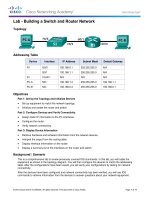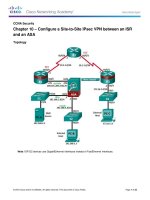Linux shell scripting tutorial a beginners handbook kho tài liệu bách khoa
Bạn đang xem bản rút gọn của tài liệu. Xem và tải ngay bản đầy đủ của tài liệu tại đây (1.07 MB, 272 trang )
Written by Vivek G. Gite.
Cyberciti Computers & nixCraft, Pune, INDIA.
This Document is Copyright (C) 1999-2002, Vivek G. Gite.
Linux Shell Scripting Tutorial v1.05r3 - A Beginner's handbook
Linux Shell Scripting
Tutorial v1.05r3
A Beginner's handbook
Copyright © 1999-2002 by Vivek G. Gite
<>
(Formally know as www.vivek-tech.com)
Table of Contents
Chapter 1: Quick Introduction to Linux
What Linux is?
Who developed the Linux?
How to get Linux?
How to Install Linux
Where I can use Linux?
What Kernel Is?
What is Linux Shell?
How to use Shell
What is Shell Script ?
Why to Write Shell Script ?
More on Shell...
Chapter 2: Getting started with Shell Programming
How to write shell script
Variables in shell
How to define User defined variables (UDV)
Rules for Naming variable name (Both UDV and System Variable)
How to print or access value of UDV (User defined variables)
echo Command
(1 of 5) [7/29/2002 6:50:01 PM]
Linux Shell Scripting Tutorial v1.05r3 - A Beginner's handbook
Shell Arithmetic
More about Quotes
Exit Status
The read Statement
Wild cards (Filename Shorthand or meta Characters)
More commands on one command line
Command Line Processing
Why Command Line arguments required
Redirection of Standard output/input i.e. Input - Output redirection
Pipes
Filter
What is Processes
Why Process required
Linux Command(s) Related with Process
Chapter 3: Shells (bash) structured Language Constructs
Decision making in shell script ( i.e. if command)
test command or [ expr ]
if...else...fi
Nested ifs
Multilevel if-then-else
Loops in Shell Scripts
for loop
Nested for loop
while loop
The case Statement
How to de-bug the shell script?
Chapter 4: Advanced Shell Scripting Commands
/dev/null - to send unwanted output of program
Local and Global Shell variable (export command)
Conditional execution i.e. && and ||
I/O Redirection and file descriptors
Functions
User Interface and dialog utility-Part I
User Interface and dialog utility-Part II
Message Box (msgbox) using dialog utility
Confirmation Box (yesno box) using dialog utility
Input (inputbox) using dialog utility
User Interface using dialog Utility - Putting it all together
trap command
The shift Command
(2 of 5) [7/29/2002 6:50:01 PM]
Linux Shell Scripting Tutorial v1.05r3 - A Beginner's handbook
getopts command
Chapter 5: Essential Utilities for Power User
Preparing for Quick Tour of essential utilities
Selecting portion of a file using cut utility
Putting lines together using paste utility
The join utility
Translating range of characters using tr utility
Data manipulation using awk utility
sed utility - Editing file without using editor
Removing duplicate lines from text database file using uniq utility
Finding matching pattern using grep utility
Chapter 6: Learning expressions with ex
Getting started with ex
Printing text on-screen
Deleting lines
Copying lines
Searching the words
Find and Replace (Substituting regular expression)
Replacing word with confirmation from user
Finding words
Using range of characters in regular expressions
Using & as Special replacement character
Converting lowercase character to uppercase
Chapter 7: awk Revisited
Getting Starting with awk
Predefined variables of awk
Doing arithmetic with awk
User Defined variables in awk
Use of printf statement
Use of Format Specification Code
if condition in awk
Loops in awk
Real life examples in awk
awk miscellaneous
sed - Quick Introduction
Redirecting the output of sed command
How to write sed scripts?
More examples of sed
Chapter 8: Examples of Shell Scripts
(3 of 5) [7/29/2002 6:50:01 PM]
Linux Shell Scripting Tutorial v1.05r3 - A Beginner's handbook
Logic Development:
Shell script to print given numbers sum of all digit
Shell script to print contains of file from given line number to next given number of lines
Shell script to say Good morning/Afternoon/Evening as you log in to system
Shell script to find whether entered year is Leap or not
Sort the given five number in ascending order (use of array)
Command line (args) handling:
Adding 2 nos. suppiled as command line args
Calculating average of given numbers on command line args
Finding out biggest number from given three nos suppiled as command line args
Shell script to implement getopts statement.
Basic math Calculator (case statement)
Loops using while & for loop:
Print nos. as 5,4,3,2,1 using while loop
Printing the patterns using for loop.
Arithmetic in shell scripting:
Performing real number calculation in shell script
Converting decimal number to hexadecimal number
Calculating factorial of given number
File handling:
Shell script to determine whether given file exist or not.
Screen handling/echo command with escape sequence code:
Shell script to print "Hello World" message, in Bold, Blink effect, and in different colors like red,
brown etc.
Background process implementation:
Digital clock using shell script
User interface and Functions in shell script:
Shell script to implements menu based system.
System Administration:
Getting more information about your working environment through shell script
Shell script to gathered useful system information such as CPU, disks, Ram and your environment
etc.
Shell script to add DNS Entery to BIND Database with default Nameservers, Mail Servers (MX)
and host
Integrating awk script with shell script:
Script to convert file names from UPPERCASE to lowercase file names or vice versa.
Chapter 9: Other Resources
Appendix - A : Linux File Server Tutorial (LFST) version b0.1 Rev. 2
Appendix - B : Linux Command Reference (LCR)
About the author
About this Document
(4 of 5) [7/29/2002 6:50:01 PM]
Linux Shell Scripting Tutorial v1.05r3 - A Beginner's handbook
Home
Up
Next
Quick Introduction to Linux
( Cyeberciti Computers & nixCraft has years of experince in Linux / Unix / FreeBSD. If you need any
assistance, education, support for Linux / Unix, write to )
(5 of 5) [7/29/2002 6:50:01 PM]
LSST v1.05r3 > Chapter 1 > Quick Introduction to Linux
Prev
Linux Shell Scripting Tutorial (LSST) v1.05r3
Chapter 1: Introduction: Quick Introduction to Linux
Next
Introduction
This tutorial is designed for beginners who wish to learn the basics of shell scripting/programming plus
introduction to power tools such as awk, sed, etc. It is not help or manual for the shell; while reading this
tutorial you can find manual quite useful (type man bash at $ prompt to see manual pages). Manual
contains all necessary information you need, but it won't have that much examples, which makes idea
more clear. For this reason, this tutorial contains examples rather than all the features of shell.
Audience for this tutorial
I assumes you have at least working knowledge of Linux i.e. basic commands like how to create, copy,
remove files/directories etc or how to use editor like vi or mcedit and login to your system. But not
expects any programming language experience. If you have access to Linux, this tutorial will provide
you an easy-to-follow introduction to shell scripting.
What's different about this tutorial
Many other tutorial and books on Linux shell scripting are either too basic, or skips important
intermediate steps. But this tutorial, maintained the balance between these two. It covers the many real
life modern example of shell scripting which are almost missed by many other
tutorials/documents/books. I have used a hands-on approach in this tutorial. The idea is very clear "do it
yourself or learn by doing" i.e. trying things yourself is the best way to learn, so examples are presented
as complete working shell scripts, which can be typed in and executed
Chapter Organization
Chapter 1 to 4 shows most of the useful and important shell scripting concepts. Chapter 5 introduction to
tools & utilities which can be used while programming the Linux shell smartly. Chapter 6 and 7 is all
about expression and expression mostly used by tools such as sed and awk. Chapter 8 is loaded with tons
of shell scripting examples divided into different categories. Chapter 9 gives more resources information
which can be used while learning the shell scripting like information on Linux file system, common
Linux command reference and other resources.
Chapter 1 introduces to basic concepts such as what is Linux, where Linux can used and continue
explaning the shell, shell script and kernel etc.
Chapter 2 shows how to write the shell script and execute them. It explains many basic concepts which
requires to write shell script.
(1 of 2) [7/29/2002 6:50:59 PM]
LSST v1.05r3 > Chapter 1 > Quick Introduction to Linux
Chapter 3 is all about making decision in shell scripting as well as loops in shell. It explains what
expression are, how shell understands the condition/decisions. It also shows you nesting concept for if
and for loop statement and debugging of shell script.
Chapter 4 introduces the many advanced shell scripting concepts such as function, user interface, File
Descriptors, signal handling, Multiple command line arguments etc.
Chapter 5 introduces to powerful utility programs which can be used variety of purpose while
programming the shell.
Chapter 6 and 7 gives more information on patterns, filters, expressions, and off course sed and awk is
covered in depth.
Chapter 8 contains lot of example of shell scripting divided into various category such as logic
development, system administration etc.
Note that indicates advanced shell scripting concepts, you can skip this if you are really new to Linux
or Programming, though this is not RECOMMENDED by me.
I hope you get as much pleasure reading this tutorial, as I had writing it. After reading this tutorial if you
are able to write your own powerful shell scripts, then I think the purpose of writing this tutorial is served
and finally if you do get time after reading this tutorial drop me an e-mail message about your
comment/suggestion/questions and off course bugs (errors) you find regarding this tutorial.
Prev
Home
Up
(2 of 2) [7/29/2002 6:50:59 PM]
Next
What Linux is?
LSST v1.05r3 > Chapter 1 > What Linux is?
Linux Shell Scripting Tutorial (LSST) v1.05r3
Chapter 1: Introduction: Quick Introduction to Linux
Prev
Next
What Linux is?
●
Free
●
Unix Like
●
Open Source
●
Network operating system
Prev
Home
Up
[7/29/2002 6:51:07 PM]
Next
Who developed the Linux?
LSST v1.05r3 > Chapter 1 > Who developed the Linux?
Prev
Linux Shell Scripting Tutorial (LSST) v1.05r3
Chapter 1: Introduction: Quick Introduction to Linux
Next
Who developed the Linux?
In 1991, Linus Torvalds studying Unix at the University, where he used special educational experimental
purpose operating system called Minix (small version of Unix and used in Academic environment). But
Minix had it's own limitations. Linus felt he could do better than the Minix. So he developed his own
version of Minix, which is now know as Linux. Linux is Open Source From the start of the day. For
more information on Linus Torvalds, please visit his home page.
Prev
What Linux is?
Home
Up
[7/29/2002 6:51:08 PM]
Next
How to get Linux?
LSST v1.05 > Chapter 1 > How to get Linux?
Prev
Linux Shell Scripting Tutorial (LSST) v1.05r3
Chapter 1: Introduction: Quick Introduction to Linux
Next
How to get Linux?
Linux available for download over the net, this is useful if your internet connection is fast. Another way
is order the CD-ROMs which saves time, and the installation from CD-ROM is fast/automatic. Various
Linux distributions available. Following are important Linux distributions.
Linux distributions.
Website/Logo
Red Hat Linux:
/>
SuSE Linux: />
Mandrake Linux:
/>
Caldera Linux:
/>
Debian GNU/Linux:
/>
Slackware Linux:
/>Note: If you are in India then you can get Linux Distribution from the Leading Computer magazine such
as PC Quest (Even PCQuest has got its own Linux flavour) or if you are in Pune, India please visit our
web site to obtained the Red Hat Linux or any other official Linux distribution. Note that you can also
obtained your Linux distribution with Linux books which you purchase from local book store.
(1 of 2) [7/29/2002 6:51:11 PM]
LSST v1.05 > Chapter 1 > How to get Linux?
Prev
Who developed the Linux?
Home
Up
(2 of 2) [7/29/2002 6:51:11 PM]
Next
How to Install Linux
LSST v1.05 > Chapter 1 > How to Install Linux ?
Prev
Linux Shell Scripting Tutorial (LSST) v1.05r3
Chapter 1: Introduction: Quick Introduction to Linux
Next
How to Install Linux ?
Please visit the LESSBS Project home page for Quick Visual Installation Guide for Red Hat Linux
version 6.2 and 7.2.
Prev
How to get Linux?
Home
Up
[7/29/2002 6:51:22 PM]
Next
Where I can use Linux?
LSST v1.05 > Chapter 1 > Where I can use Linux?
Prev
Linux Shell Scripting Tutorial (LSST) v1.05r3
Chapter 1: Introduction : Linux Shell basics
Next
Where I can use Linux?
You can use Linux as Server Os or as stand alone Os on your PC. (But it is best suited for Server.) As a
server Os it provides different services/network resources to client. Server Os must be:
● Stable
● Robust
● Secure
● High Performance
Linux offers all of the above characteristics plus its Open Source and Free OS. So Linux can be used as:
(1) On stand alone workstation/PC for word processing, graphics, software development, internet,
e-mail, chatting, small personal database management system etc.
(2) In network environment as:
(A) File and Print or Application Server
Share the data, Connect the expensive device like printer and share it, e-mail within the LAN/intranet etc
are some of the application.
Linux Server with different Client Os
(B) Linux sever can be connected to Internet, So that PC's on intranet can share the internet/e-mail etc.
You can put your web sever that run your web site or transmit the information on the internet.
(1 of 2) [7/29/2002 6:51:26 PM]
LSST v1.05 > Chapter 1 > Where I can use Linux?
Linux Server can act as Proxy/Mail/WWW/Router Server etc.
So you can use Linux for:
● Personal Work
● Web Server
● Software Development Workstation
● Workgroup Server
● In Data Center for various server activities such as FTP, Telnet, SSH, Web, Mail, Proxy, Proxy
Cache Appliance etc
See the LESSBS project for more information on Linux Essential Services (as mentioned above) and
how to implement them in easy manner for you or your organization.
Prev
How to Install Linux
Home
Up
(2 of 2) [7/29/2002 6:51:26 PM]
Next
What Kernel Is?
LSST v1.05 > Chapter 1 > LSST v1.05 > Chapter 1 >
Prev
Linux Shell Scripting Tutorial (LSST) v1.05r3
Chapter 1: Introduction : Linux Shell basics
Next
What Kernel Is?
Kernel is heart of Linux Os.
It manages resource of Linux Os. Resources means facilities available in Linux. For e.g. Facility to store
data, print data on printer, memory, file management etc .
Kernel decides who will use this resource, for how long and when. It runs your programs (or set up to
execute binary files).
The kernel acts as an intermediary between the computer hardware and various
programs/application/shell.
It's Memory resident portion of Linux. It performance following task :● I/O management
● Process management
● Device management
● File management
● Memory management
Prev
Where I can use Linux?
Home
Up
[7/29/2002 6:51:28 PM]
Next
What is Linux Shell?
LSST v1.05 > Chapter 1 > What is Linux Shell ?
Prev
Linux Shell Scripting Tutorial (LSST) v1.05r3
Chapter 1: Introduction : Linux Shell basics
Next
What is Linux Shell ?
Computer understand the language of 0's and 1's called binary language.
In early days of computing, instruction are provided using binary language, which is difficult for all of
us, to read and write. So in Os there is special program called Shell. Shell accepts your instruction or
commands in English (mostly) and if its a valid command, it is passed to kernel.
Shell is a user program or it's a environment provided for user interaction. Shell is an command language
interpreter that executes commands read from the standard input device (keyboard) or from a file.
Shell is not part of system kernel, but uses the system kernel to execute programs, create files etc.
Several shell available with Linux including:
Shell Name
BASH ( Bourne-Again
SHell )
Developed by
Brian Fox and Chet
Ramey
CSH (C SHell)
Bill Joy
KSH (Korn SHell)
TCSH
David Korn
See the man page.
Type $ man tcsh
Where
Free Software
Foundation
Remark
Most common shell in
Linux. It's Freeware
shell.
University of California The C shell's syntax and
(For BSD)
usage are very similar to
the C programming
language.
AT & T Bell Labs
--TCSH is an enhanced
but completely
compatible version of
the Berkeley UNIX C
shell (CSH).
Tip: To find all available shells in your system type following command:
$ cat /etc/shells
Note that each shell does the same job, but each understand a different command syntax and provides
different built-in functions.
In MS-DOS, Shell name is COMMAND.COM which is also used for same purpose, but it's not as
powerful as our Linux Shells are!
Any of the above shell reads command from user (via Keyboard or Mouse) and tells Linux Os what users
want. If we are giving commands from keyboard it is called command line interface ( Usually in-front of
$ prompt. This prompt is depend upon your shell and Environment that you set or by your System
Administrator, therefore you may get different prompt ).
(1 of 2) [7/29/2002 6:51:30 PM]
LSST v1.05 > Chapter 1 > What is Linux Shell ?
Tip: To find your current shell type following command
$ echo $SHELL
Prev
What Kernel Is?
Home
Up
(2 of 2) [7/29/2002 6:51:30 PM]
Next
How to use Shell
LSST v1.05 > Chapter 1 > How to use Shell
Prev
Linux Shell Scripting Tutorial (LSST) v1.05r3
Chapter 1: Introduction : Linux Shell basics
Next
How to use Shell
To use shell (You start to use your shell as soon as you log into your system) you have to simply type
commands.
See common Linux Command for syntax and example, this can be used as quick reference while
programming the shell.
Prev
What is Linux Shell?
Home
Up
[7/29/2002 6:51:31 PM]
Next
What is Shell Script ?
LSST v1.05 > Chapter 1 > What is Shell Script ?
Prev
Linux Shell Scripting Tutorial (LSST) v1.05r3
Chapter 1: Introduction : Linux Shell basics
Next
What is Shell Script ?
Normally shells are interactive. It means shell accept command from you (via keyboard) and execute
them. But if you use command one by one (sequence of 'n' number of commands) , the you can store this
sequence of command to text file and tell the shell to execute this text file instead of entering the
commands. This is know as shell script.
Shell script defined as:
"Shell Script is series of command written in plain text file. Shell script is just like batch file is MS-DOS
but have more power than the MS-DOS batch file."
Prev
How to use Shell
Home
Up
[7/29/2002 6:51:33 PM]
Next
Why to Write Shell Script ?
LSST v1.05 > Chapter 1 > Why to Write Shell Script ?
Linux Shell Scripting Tutorial (LSST) v1.05r3
Chapter 1: Introduction : Linux Shell basics
Prev
Next
Why to Write Shell Script ?
●
●
●
●
●
Shell script can take input from user, file and output them on screen.
Useful to create our own commands.
Save lots of time.
To automate some task of day today life.
System Administration part can be also automated.
Prev
What is Shell Script ?
Home
Up
[7/29/2002 6:51:34 PM]
Next
More on Shell...
LSST v1.05 > Chapter 1 > Linux Shell basics
Prev
Linux Shell Scripting Tutorial (LSST) v1.05r3
Chapter 1: Introduction : Linux Shell basics
Next
Which Shell We are using to write Shell
Script ?
In this tutorial we are using bash shell.
Objective of this Tutorial (LSST v.1.5)
Try to understand Linux Os
Try to understand the basics of Linux shell
Try to learn the Linux shell programming
What I need to learn this Tutorial (LSST
v.1.5)
Linux OS ( I have used Red Hat Linux distribution Version 6.x+)
Web Browse to read tutorial. (IE or Netscape) For PDF version you need PDF reader.
Linux - bash shell. (Available with almost all Linux Distributions. By default bash is default shell for
Red Hat Linux Distribution). All the scripts are also tested on Red Hat Linux version 7.2.
Prev
Why to Write Shell Script ?
Home
Up
[7/29/2002 6:51:36 PM]
Next
Getting started with Shell Programming
LSST v1.05r3 > Chapter 2 > Getting started with Shell Programming
Linux Shell Scripting Tutorial (LSST) v1.05r3
Chapter 2: Getting started with Shell Programming
Prev
Next
Getting started with Shell Programming
In this part of tutorial you are introduced to shell programming, how to write script, execute them etc.
We will be getting started with writing small shell script, that will print "Knowledge is Power" on screen.
Before starting with this you should know
● How to use text editor such as vi, see the common vi command for more information.
●
Basic command navigation
Prev
More on Shell...
[7/29/2002 6:51:37 PM]
Home
Up
Next
How to write shell script
LSST v1.05r3 > Chapter 2 > How to write shell script
[Advertisement]
[Get Cyberciti Domain for Just Rs.445 with 2 Free e-mail]
Prev
Linux Shell Scripting Tutorial (LSST) v1.05r3
Chapter 2: Getting started with Shell Programming
Next
How to write shell script
Following steps are required to write shell script:
(1) Use any editor like vi or mcedit to write shell script.
(2) After writing shell script set execute permission for your script as follows
syntax:
chmod permission your-script-name
Examples:
$ chmod +x your-script-name
$ chmod 755 your-script-name
Note: This will set read write execute(7) permission for owner, for group and other permission is read and execute only(5).
(3) Execute your script as
syntax:
bash your-script-name
sh your-script-name
./your-script-name
Examples:
$ bash bar
$ sh bar
$ ./bar
NOTE In the last syntax ./ means current directory, But only . (dot) means execute given command file in current shell
without starting the new copy of shell, The syntax for . (dot) command is as follows
Syntax:
. command-name
Example:
$ . foo
Now you are ready to write first shell script that will print "Knowledge is Power" on screen. See the common vi command
list , if you are new to vi.
$ vi first
#
# My first shell script
#
clear
echo "Knowledge is Power"
After saving the above script, you can run the script as follows:
$ ./first
(1 of 2) [7/29/2002 6:51:39 PM]
LSST v1.05r3 > Chapter 2 > How to write shell script
This will not run script since we have not set execute permission for our script first; to do this type command
$ chmod 755 first
$ ./first
First screen will be clear, then Knowledge is Power is printed on screen.
Script Command(s)
Meaning
$ vi first
Start vi editor
# followed by any text is considered as
comment. Comment gives more
information about script, logical
explanation about shell script.
Syntax:
# comment-text
clear the screen
To print message or value of variables on
screen, we use echo command, general
form of echo command is as follows
syntax:
echo "Message"
#
# My first shell script
#
clear
echo "Knowledge is Power"
How Shell Locates the file (My own bin directory to execute script)
Tip: For shell script file try to give file extension such as .sh, which can be easily identified by you as shell script.
Exercise:
1)Write following shell script, save it, execute it and note down it's output.
$ vi ginfo
#
#
# Script to print user information who currently login , current date
& time
#
clear
echo "Hello $USER"
echo "Today is \c ";date
echo "Number of user login : \c" ; who | wc -l
echo "Calendar"
cal
exit 0
Future Point: At the end why statement exit 0 is used? See exit status for more information.
Prev
Getting started with Shell Programming
Home
Up
[Advertisement]
[Get Cyberciti Domain for Just Rs.445 with 2 Free e-mail]
(2 of 2) [7/29/2002 6:51:39 PM]
Next
Variables in Shell









